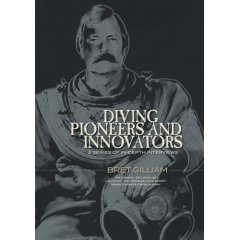Review of Bret Gilliam’s “Diving Pioneers and Innovators”

When Eric Cheng asked me to write a review of Bret Gilliam’s Diving Pioneers and Innovators, I turned him down on the basis of conflict of interest. After all, I had written one of the chapters, and Bret acknowledged that the inspiration for his tome came from my 1994 book, Diving Pioneers.
But after two months had gone by, and nobody else stepped up to the plate, I reluctantly agreed to try to distance myself and go ahead with it. So here’s my somewhat biased opinion.
Bret Gilliam has taken my idea and run with it, beyond anything I ever conceived. His book consists of 19 in-depth interviews with some of the pioneers, movers, and shakers of diving. They range in time from the 1950s Zale Parry to present day icons like John Chatterton and Wes Skiles. The careers of some of these still-active divers span nearly the entire history of scuba diving: Stan Waterman, Bev Morgan, Ron and Valerie Taylor, and Chuck Nicklin. Michele Hall rates her own chapter, as does Howard. Peter Benchley, Bob Ballard, and Greg MacGillivray have transcended our diving world and are well known outside its provincial boundaries. Bob Hollis and Dick Bonin were innovative manufacturers. Al Giddings, Mike DeGruy, Paul Humann, and Ernie Brooks round out a pennant winning lineup.
Gilliam himself is the subject of the final chapter, interviewed by longtime professional collaborator Lina Hitchcock. He claims to have been dragged in kicking and screaming. Fred Garth, Douglas David Seifert, Danielle Alary and Michel Gilbert, and I wrote chapters; the rest are Gilliam’s.
The book fills 489 pages and weighs 4 ½ pounds, so it hardly qualifies as airplane reading. Instead it’s something to take into a comfortable chair in the living room and read a chapter or two each night. It’s almost like having a diving legend sitting in the chair next to you, and carrying on a conversation with an old friend. The divers reveal their personalities, their sense of humor, their philosophy, and some amazing tales ranging from triumph to tragedy. Brett and his co-authors ask the questions you might ask, had you done your homework and were up to speed on the life of the person you were speaking with. The questions aren’t all softballs either. Bret isn’t exactly known for subtlety, and the subjects don’t dance around the tough questions. You won’t find pat quotables such as, “I am not a crook,” “I never had sex with that woman,” or “I’m looking for the real killer,” in its pages.
This book is fascinating reading, and a significant contribution to preserving the history of our activity. It’s got enough high quality illustrations to qualify as coffee table furniture, but is far more readable than most examples of this genre. Having written three books myself, I know how frustrating it can be to have to make compromises to meet a limited budget. That wasn’t done here. It’s a quality product, priced to make a profit. The only nitpicking I’d point out is that a few typos escaped the eyes of the copy editors, like an easy ground ball bobbled by a slick fielding shortstop.
Very few books have the ability to convey the soul and excitement of diving to that segment of the public that has never gone underwater. This is one of them.
—
Review by Eric Hanauer